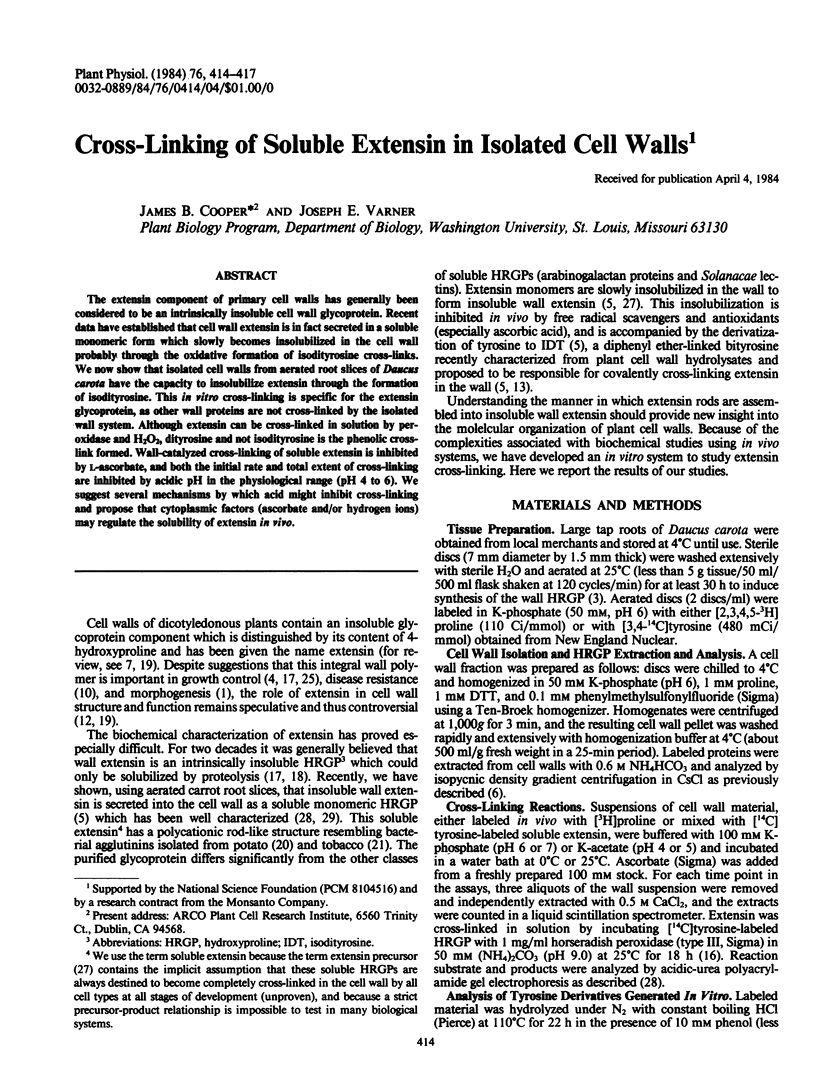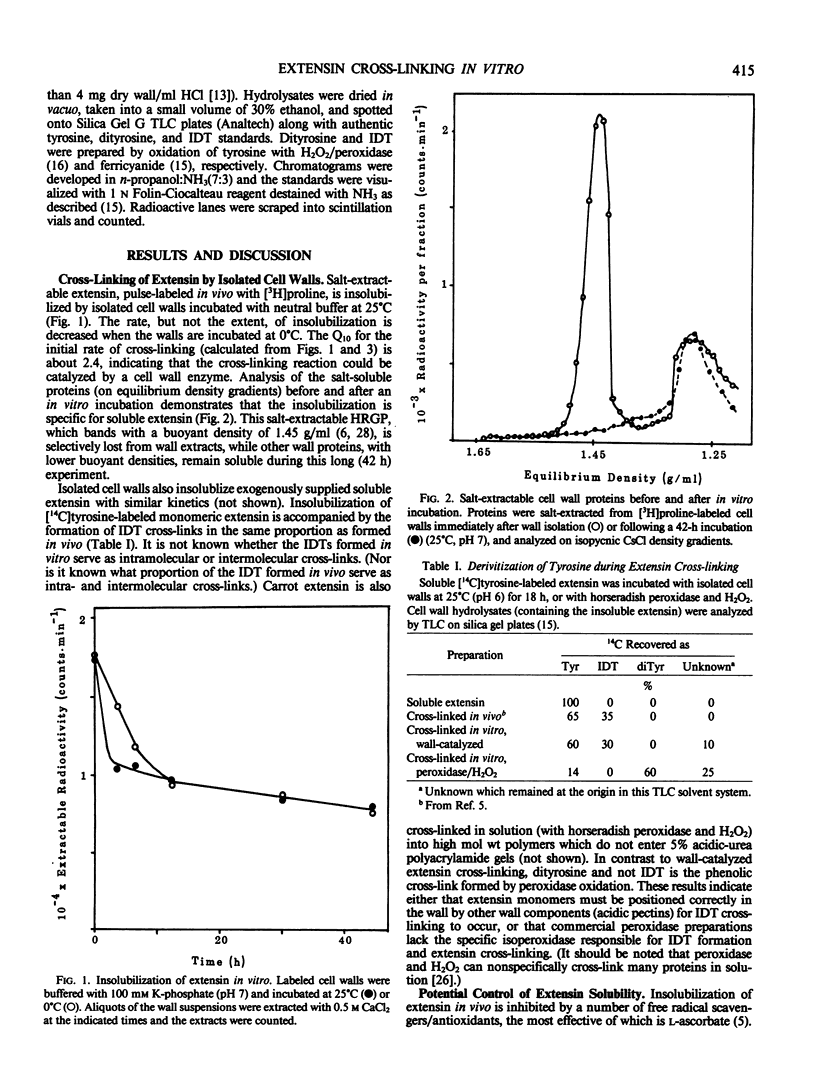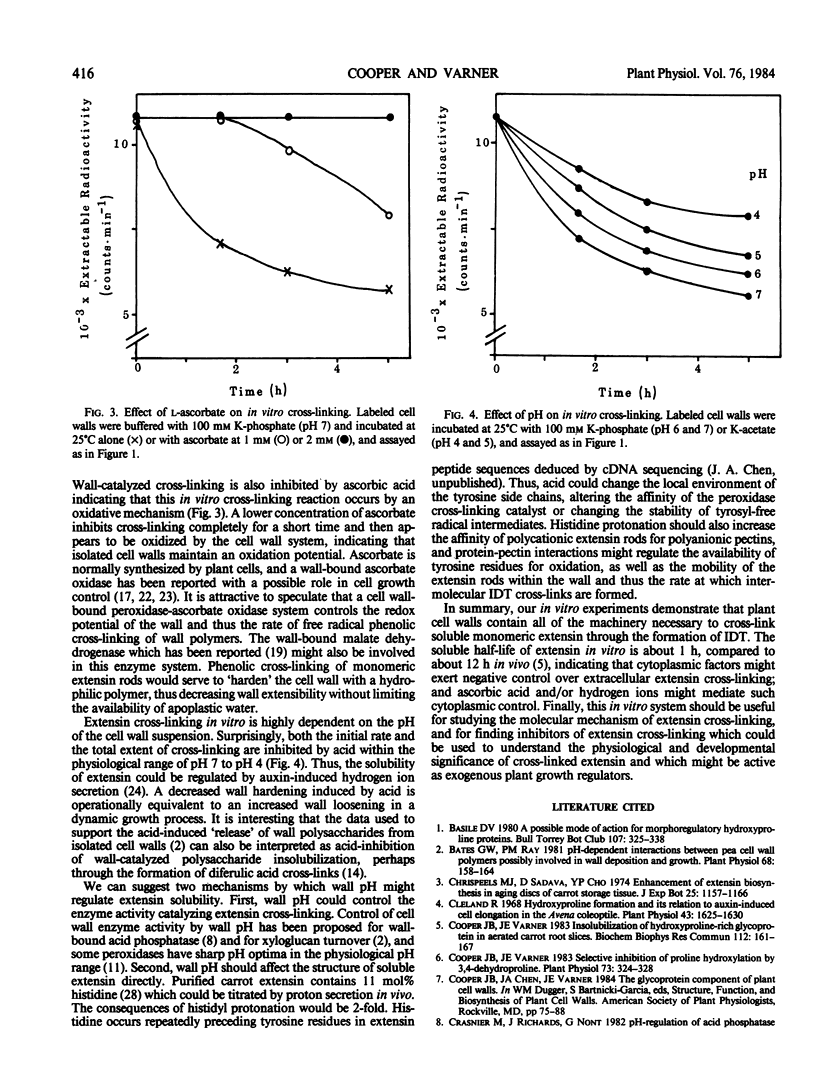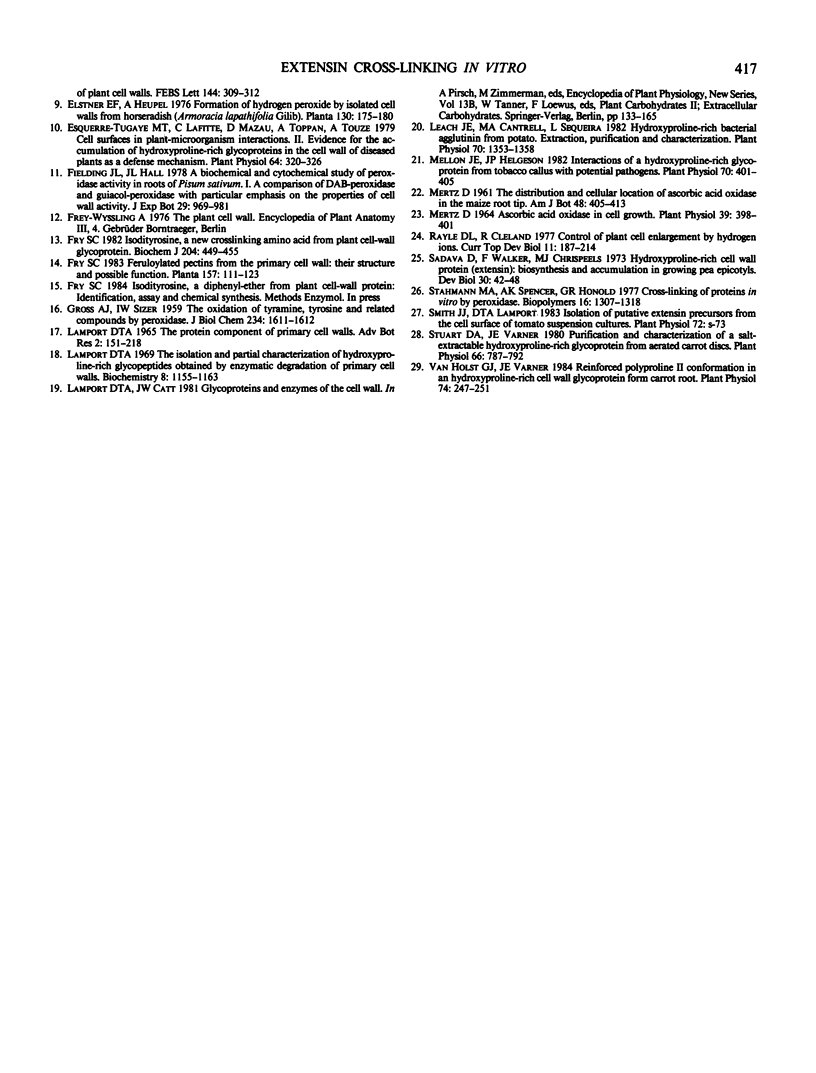Abstract
The extensin component of primary cell walls has generally been considered to be an intrinsically insoluble cell wall glycoprotein. Recent data have established that cell wall extensin is in fact secreted in a soluble monomeric form which slowly becomes insolubilized in the cell wall probably through the oxidative formation of isodityrosine cross-links. We now show that isolated cell walls from aerated root slices of Daucus carota have the capacity to insolubilize extensin through the formation of isodityrosine. This in vitro cross-linking is specific for the extensin glycoprotein, as other wall proteins are not cross-linked by the isolated wall system. Although extensin can be cross-linked in solution by peroxidase and H2O2, dityrosine and not isodityrosine is the phenolic cross-link formed. Wall-catalyzed cross-linking of soluble extensin is inhibited by l-ascorbate, and both the initial rate and total extent of cross-linking are inhibited by acidic pH in the physiological range (pH 4 to 6). We suggest several mechanisms by which acid might inhibit cross-linking and propose that cytoplasmic factors (ascorbate and/or hydrogen ions) may regulate the solubility of extensin in vivo.
Full text
PDF



Selected References
These references are in PubMed. This may not be the complete list of references from this article.
- Bates G. W., Ray P. M. pH-Dependent Interactions between Pea Cell Wall Polymers Possibly Involved in Wall Deposition and Growth. Plant Physiol. 1981 Jul;68(1):158–164. doi: 10.1104/pp.68.1.158. [DOI] [PMC free article] [PubMed] [Google Scholar]
- Cleland R. Hydroxyproline Formation and Its Relation to Auxin-induced Cell Elongation in the Avena Coleoptile. Plant Physiol. 1968 Oct;43(10):1625–1630. doi: 10.1104/pp.43.10.1625. [DOI] [PMC free article] [PubMed] [Google Scholar]
- Cooper J. B., Varner J. E. Insolubilization of hydroxyproline-rich cell wall glycoprotein in aerated carrot root slices. Biochem Biophys Res Commun. 1983 Apr 15;112(1):161–167. doi: 10.1016/0006-291x(83)91811-9. [DOI] [PubMed] [Google Scholar]
- Cooper J. B., Varner J. E. Selective inhibition of proline hydroxylation by 3,4-dehydroproline. Plant Physiol. 1983 Oct;73(2):324–328. doi: 10.1104/pp.73.2.324. [DOI] [PMC free article] [PubMed] [Google Scholar]
- Esquerré-Tugayé M. T., Lafitte C., Mazau D., Toppan A., Touzé A. Cell Surfaces in Plant-Microorganism Interactions: II. Evidence for the Accumulation of Hydroxyproline-rich Glycoproteins in the Cell Wall of Diseased Plants as a Defense Mechanism. Plant Physiol. 1979 Aug;64(2):320–326. doi: 10.1104/pp.64.2.320. [DOI] [PMC free article] [PubMed] [Google Scholar]
- Fry S. C. Isodityrosine, a new cross-linking amino acid from plant cell-wall glycoprotein. Biochem J. 1982 May 15;204(2):449–455. doi: 10.1042/bj2040449. [DOI] [PMC free article] [PubMed] [Google Scholar]
- GROSS A. J., SIZER I. W. The oxidation of tyramine, tyrosine, and related compounds by peroxidase. J Biol Chem. 1959 Jun;234(6):1611–1614. [PubMed] [Google Scholar]
- Lamport D. T. The isolation and partial characterization of hydroxyproline-rich glycopeptides obtained by enzymic degradation of primary cell walls. Biochemistry. 1969 Mar;8(3):1155–1163. doi: 10.1021/bi00831a049. [DOI] [PubMed] [Google Scholar]
- Leach J. E., Cantrell M. A., Sequeira L. Hydroxyproline-rich bacterial agglutinin from potato : extraction, purification, and characterization. Plant Physiol. 1982 Nov;70(5):1353–1358. doi: 10.1104/pp.70.5.1353. [DOI] [PMC free article] [PubMed] [Google Scholar]
- Mertz D. Ascorbic Acid Oxidase in Cell Growth. Plant Physiol. 1964 May;39(3):398–401. doi: 10.1104/pp.39.3.398. [DOI] [PMC free article] [PubMed] [Google Scholar]
- Rayle D. L., Cleland R. Control of plant cell enlargement by hydrogen ions. Curr Top Dev Biol. 1977;11:187–214. doi: 10.1016/s0070-2153(08)60746-2. [DOI] [PubMed] [Google Scholar]
- Sadava D., Walker F., Chrispeels M. J. Hydroxyproline-rich wall protein (extensin): biosynthesis and accumulation in growing pea epicotyls. Dev Biol. 1973 Jan;30(1):41–48. [PubMed] [Google Scholar]
- Stahmann M. A., Spencer A. K. Cross linking of proteins in vitro by peroxidase. Biopolymers. 1977 Jun;16(6):1307–1318. doi: 10.1002/bip.1977.360160611. [DOI] [PubMed] [Google Scholar]
- Stuart D. A., Varner J. E. Purification and Characterization of a Salt-extractable Hydroxyproline-rich Glycoprotein from Aerated Carrot Discs. Plant Physiol. 1980 Nov;66(5):787–792. doi: 10.1104/pp.66.5.787. [DOI] [PMC free article] [PubMed] [Google Scholar]
- van Holst G. J., Varner J. E. Reinforced Polyproline II Conformation in a Hydroxyproline-Rich Cell Wall Glycoprotein from Carrot Root. Plant Physiol. 1984 Feb;74(2):247–251. doi: 10.1104/pp.74.2.247. [DOI] [PMC free article] [PubMed] [Google Scholar]


